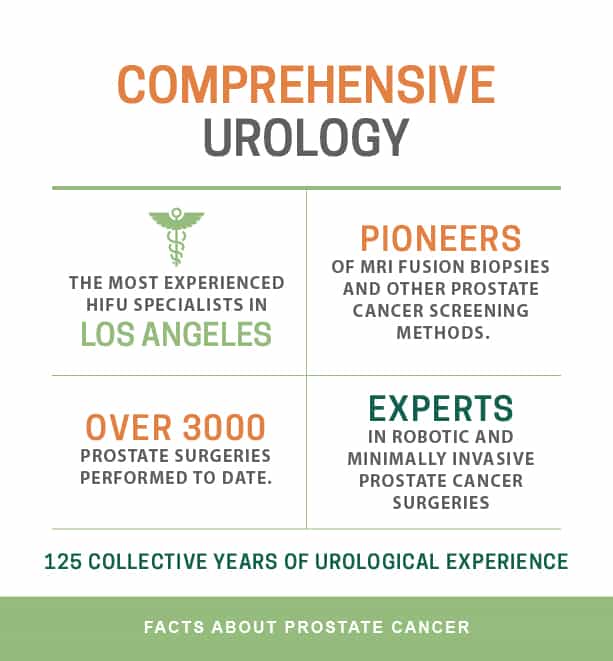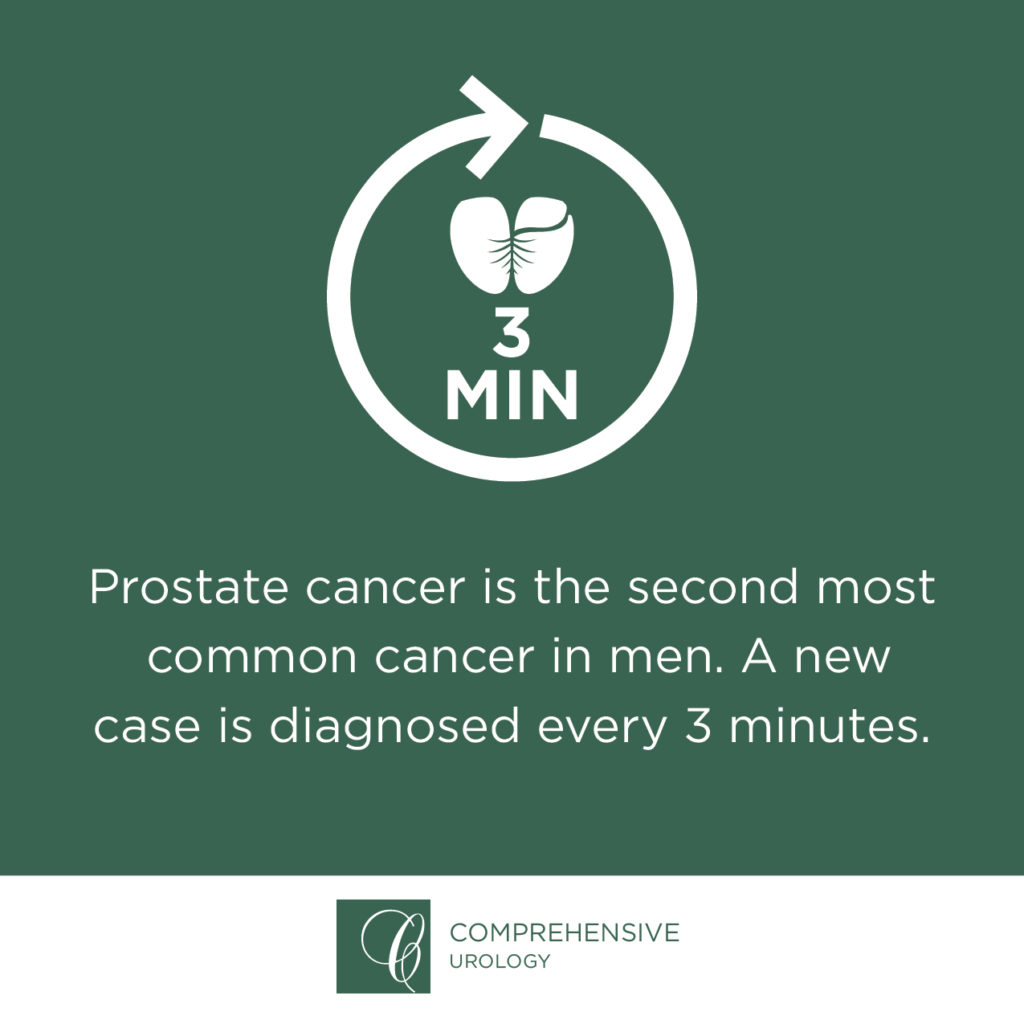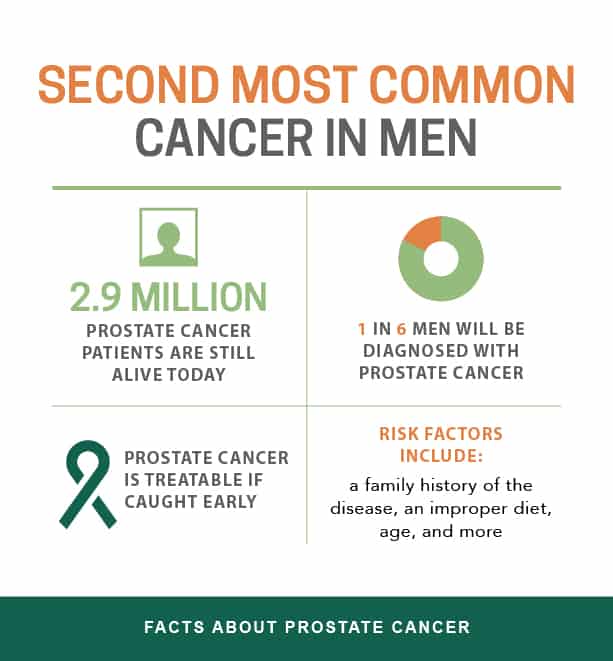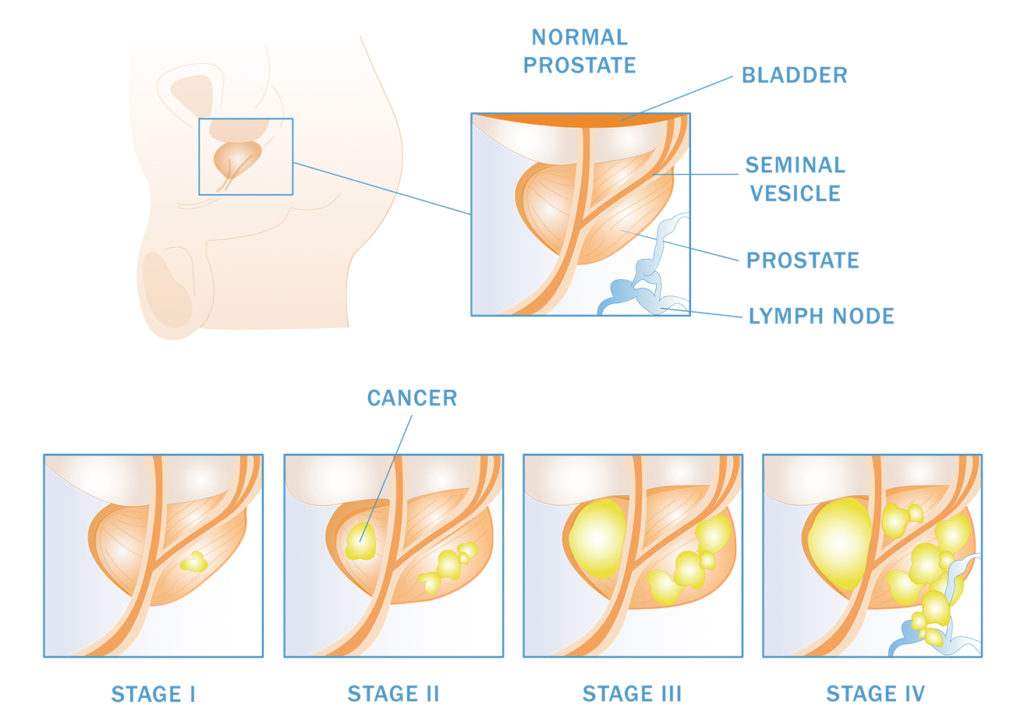What is Prostate Cancer?

With over 3,000 prostate surgeries performed to date, the urological leaders at Comprehensive Urology have over 125 years of collective experience in treating prostate cancer and all of its symptoms.
Comprehensive Urology is an industry leader in providing cutting-edge, minimally invasive treatment for prostate cancer with compassion and an individualized approach for each patient. If you’ve been diagnosed with prostate cancer, or have a family history of the disease, it’s important to know your treatment options and to have a general understanding of what’s involved during the treatment process.
We hope that this information serves as a good starting point in regards to prostate cancer treatment. Please continue reading to learn more about this disease and the numerous therapies that our board-certified urologists use to treat it.
Prostate Cancer Experts
The Comprehensive Urology team works in conjunction with expert healthcare professionals to diagnose and treat prostate cancer patients. Our collaborative approach ensures each patient receives in-depth support and personalized care at all times.
We hope that this information serves as a good starting point in regards to prostate cancer treatment. Please continue reading to learn more about this disease and the numerous therapies that our board-certified urologists use to treat it.
What is Prostate Cancer?
Prostate cancer normally starts in the gland cells and is called adenocarcinoma. This type of cancer is considered to be a slow, progressive disease that is not as easily detected compared to other forms of cancer. Prostate cancer starts with microscopic alterations in the shape and size of the prostate gland cells, which is referred to as prostatic intraepithelial neoplasia (PIN).
Nearly all prostate cancers are adenocarcinomas that develop from the gland cells.
Most prostate cancers grow slowly, but some have been shown to quickly grow and spread. Also, prostate cancer often shows no symptoms until it spreads. With an early-st
prostate cancer diagnosis, men are better equipped than ever before to fully treat this condition.
Incidence of Prostate Cancer
Approximately one in nine men will receive a prostate diagnosis during his lifetime, according to the American Cancer Society (ACS). Prostate cancer is also more prominent in older men and African-American men than others, and the condition is very rarely diagnosed before the age of 40.
Although prostate cancer is a serious condition, most men who have received a prostate cancer diagnosis at some point in their lifetime are still alive today. In general prostate cancer tends to be fatal in about 1 of 8 affected individuals as their cause of death, and most actually die with it but of other causes. With proper diagnosis and treatment, men can manage prostate cancer symptoms.
4 Risk Factors for Prostate Cancer
When diagnosed early, prostate cancer is one of the most treatable and even curable forms of cancer. Though there are a variety of prostate cancer risk factors, the cancer is usually slow-growing, and the causes of the disease are multifactorial and can include the following.
1. Age
Prostate cancer is rare in young men, but after age 45 to 50 the risk progressively increases. 60% of prostate cancer diagnoses are in men 65 or older, and the average age of a prostate cancer patient is 66 years old. However, other factors could cause prostate cancer to develop earlier, and these causes are listed below.
2. Genetic Link
Men with a family history of prostate cancer have double the risk of developing the disease. The risk is even higher for men with several affected relatives, particularly if their relatives were young at the time of diagnosis. Scientists have identified several inherited genes that seem to increase risk, but they probably account for only a small fraction of cases. Genetic testing for these genes is not yet available.
3. Ethnicity
Ethnic origin also plays a part in the development of prostate cancer: men of African heritage seem to be at highest risk, and men of Far Eastern descent the lowest. Men who are at higher risk (family history or African origin) are screened at an earlier age in order to find the cancer at its earliest stages when the potential for cure is the highest. At Comprehensive Urology, we recommend that African American men be screened at the age of 40, regardless of their family history of prostate cancer.
4. Diet
Maintaining a healthy diet is an important step when it comes to reducing your risk of prostate cancer. There have been studies linking prostate cancer to a high animal fat and red meat diet, and it may be possible to reduce the risk of developing cancer by cutting down on dairy foods, red meats, and other foods rich with saturated fats.
Exposure to certain agricultural pesticides may be associated with an increased risk of prostate cancer. There is also a weak association between prostate cancer and cadmium exposure. Additionally, some studies have linked a previous history of prostate infection to a higher risk of developing cancer.
Prostate Cancer Screening Tests
It is possible to detect the early signs of prostate carcinoma from the convenience of the Prostate Cancer Specialists of Los Angeles’ office with the following tests:
Digital Rectal Exam
The doctor simply inserts a lubricated and gloved finger into the lower part of the rectum to feel whether there are any lumps or abnormalities on the prostate. An experienced urologist can evaluate the shape, size, and texture of the prostate to identify whether the patient is more likely to have prostate cancer or a benign condition.
Prostate-Specific Antigen Blood Test
Prostate-specific antigen is a protein that is released by the prostate gland in minuscule amounts into the bloodstream. In some cases, the prostate can release excess levels of PSA, whether due to a prostatic benign hyperplasia, cancer, or other complication. The PSA test is used to detect the level of prostate-specific antigens in a man’s blood to determine if a further screening is necessary or whether to take an active surveillance approach.
Transrectal Ultrasound (TRUS)
In the event of abnormal results found in a DRE or PSA test, an additional conservative method for screening may be used involving a transrectal ultrasound. A small probe is lubricated and inserted into the rectum where it will emit sound waves and pick up the echoes and transmit the date into black and white computer images. The procedure takes no more than 10 minutes and does not cause any pain. The black and white images can be used to evaluate whether further diagnostic tests should be conducted.
Other health conditions, such as obesity, can contribute to higher than average PSA levels, therefore, it is important to get screened by an expert urologist with extensive experience evaluating cancer screening tests. There are numerous factors that must be taken into account when conducting reliable prostate cancer screening tests and the Prostate Cancer Specialists of Los Angeles provide comprehensive care to ensure that each patient receives the personalized screening and treatment he needs.
Depending on the results of the various prostate cancer screening tests, the urologist may schedule a procedure called a prostate biopsy. The procedure involves taking small samples of the gland tissue with a thin hollow needle.
Diagnosing Prostate Cancer
Sometimes, our physician will order additional diagnostic exams to help determine if the prostate cancer is limited to the prostate or if it has spread. These tests may include a bone scan, CT scan, MRI, and/or lymph node biopsy. These tests are usually performed when there is a suspicion of aggressive or advanced disease (e.g., a PSA score greater than 10 or bone pain).
Prostate Mapping
Prostate mapping involves the use of specific tests to help men understand the risks associated with prostate cancer. It is also used to help men determine if they have prostate cancer. If prostate cancer is discovered, additional testing is used to evaluate the cancer’s precise location, number of tumors, and grade.
With prostate mapping, a urologist uses MRI and/or transperineal template-guided biopsy testing. This helps a urologist provide an accurate prostate cancer diagnosis.
Prostate Biopsy
During a prostate biopsy, a urologist inserts a needle into the wall of a patient’s rectum. A urologist next extracts prostate cells for testing and collects samples from multiple parts of the prostate. Then, a urologist sends the prostate tissue samples to a laboratory, where they are reviewed under a microscope.
Prostate biopsy results are generally available within a few days. If a urologist identifies prostate cancer, he or she will provide a patient with a Gleason score based on the aggressiveness of the cancer.
MRI Fusion Biopsy
The board certified and award-winning team of prostate cancer specialists at Comprehensive Urology uses an enhanced imaging and diagnostic technique known as MRI fusion biopsy. Because tumors are not always detectable on ultrasound exams alone, MRI (magnetic resonance imaging) screenings can provide more detailed results.
An MRI fusion biopsy goes a step further than a regular prostate cancer test. It merges the images and data from an ultrasound and MRI images to offer urologists a more precise, accurate view of the prostate and the size, location, and severity of the tumor(s).
Prostate Cancer Grading and Staging
If cancerous cells are found, a pathologist at Comprehensive Urology will use a grading system – called Gleason grading – to help describe how aggressive the cancer is.
The pathologist will evaluate the two largest areas of cancer and will give each section a grade from 1 (least aggressive) to 5 (most aggressive).
When these two numbers are added together, it represents the total “Gleason score” of the cancer. A higher score signifies a more aggressive cancer. Depending on each individual’s score, the urologists at Comprehensive Urology will develop a personalized treatment approach that’s unique to your cancer’s grade, stage, and more.
For more information about grading and staging prostate cancer, please contact our Los Angeles urologists today.
Staging of Prostate Cancer
In order to determine how much cancer is present, how fast the cancer is growing, and to determine if the cancer is still localized to the prostate (early stage) or if it has spread beyond the prostate (late stage), our physicians will use the following clinical information:
- The findings noted on the rectal examination,
- The Gleason grade of the cancer
- How much tumor is present in the biopsy specimen,
- How many different areas of the prostate had detectable cancer cells,
- The PSA value, and
- The size of the prostate
Prostate Cancer Treatments
 Comprehensive Urology offers a variety of treatment methods for prostate cancer. Like other forms of the cancer, prostate cancer treatment is determined by a few factors, including the grade and stage of the disease, a patient’s age, and more. Once your cancer has been diagnosed and studied, our specialists will determine a specific treatment plan that’s unique to you and your lifestyle.
Comprehensive Urology offers a variety of treatment methods for prostate cancer. Like other forms of the cancer, prostate cancer treatment is determined by a few factors, including the grade and stage of the disease, a patient’s age, and more. Once your cancer has been diagnosed and studied, our specialists will determine a specific treatment plan that’s unique to you and your lifestyle.
Patients with prostate cancer can benefit from the following treatments. Each treatment option is beneficial to certain individuals, as there is no “one size fits all” approach to prostate cancer treatments. However, the prostate cancer specialists at Comprehensive Urology in Los Angeles can help you choose a treatment plan that is specifically tailored to you and your condition.
Active Surveillance: Involves monitoring prostate cancer symptoms over an extended period of time. With active surveillance, a prostate cancer patient will receive a clinical assessment of symptoms, monitor the prostate with rectal examinations and PSA testing, use prostate imaging, and perform prostate biopsies at regular intervals.
Robotic Prostate Cancer Surgery: Requires the use of the da Vinci® robotic surgical machine to remove malignant or enlarged prostate tissue. Robotic prostate cancer surgery is minimally invasive and enables a surgeon to use small, precise instruments to treat patients.
High-Intensity Focused Ultrasound (HIFU): Uses high-frequency ultrasound waves to heat and destroy cancer cells within the prostate. HIFU targets cancerous tissue and ensures tissue outside the focal point remains intact.
MRI Brachytherapy: Involves the placement of radioactive seed implants into the prostate gland to help localize radiation treatment to the prostate and minimize the effects to the surrounding structures (bladder and rectum).
Cryotherapy: Requires freezing the prostate with liquid nitrogen. Cryotherapy is commonly used to address the recurrence of prostate cancer after radiation treatment has failed.
Hormonal Therapy: Helps reduce a man’s supply of testosterone, the hormone that makes prostate cancer cells grow quickly. Hormonal therapy targets cancer that has spread beyond the prostate gland.
Intensity-Modulated Radiation Therapy (IMRT)/MRI TrueBeam Therapy: Targets and administers radiation to prostate cancer cells with unparalleled accuracy and precision. IMRT usually takes about eight-and-a-half weeks to administer.
The Comprehensive Urology team will discuss all treatment options with prostate cancer patients, respond to any concerns or questions, and help patients determine the optimal treatment.
Frequently Asked Questions
 The team at Comprehensive Urology in Beverly Hills provides diagnostic capabilities and treatment options that are among the most sophisticated and effective in the country.
The team at Comprehensive Urology in Beverly Hills provides diagnostic capabilities and treatment options that are among the most sophisticated and effective in the country.
Patients from across the United States and even around the world seek out the practice’s industry-leading expertise and knowledge of the most advanced and cutting-edge treatments available for patients diagnosed with prostate cancer at any stage.
Click on the question to see the answer
Q: What is prostate cancer?
Q: What causes prostate cancer?
- Age. The primary risk factor in developing prostate cancer is age. The risk is higher with age as there are more diagnoses of prostate cancer with men over the age of 50.
- Genetics. Family history also plays a major factor in prostate cancer risk. A man whose brother or father was diagnosed with the illness runs twice the risk of developing prostate cancer, compared to other men who do not have any affected family members.
- Ethnicity. African Americans are at a higher risk of the disease. Because of this, we recommend that African American men be screened at the age of 40, regardless of their family history of the disease.
- Diet. A few research studies have shown that certain diets, specifically a Mediterranean diet, may help reduce a person’s chances of developing prostate cancer. Some recent studies promote the consumption of vegetables and vitamin B to be beneficial in the prevention of prostate cancer.
- Obesity. Those who are obese have been linked to an increased chance of developing cancer of the prostate.
- Other factors that increase the likelihood of developing cancer are linked to medication history and the contraction of sexually transmitted diseases (STDs).
Q: What are the signs and symptoms of prostate cancer?
- Frequent need to urinate, especially at night
- Problems with starting urination or holding back urine
- Weak or interrupted urine flow
- Pain or burning during urination
- Difficulty with erection
- Painful ejaculation
- Blood in urine or semen
- Frequent pain or stiffness in lower back, upper thighs, or hips
While the presence of any or a combination of symptoms does not necessarily indicate prostate cancer, men experiencing any symptoms should consult with a urologist as soon as possible.
Q: When should I seek a second opinion?
Q: What is the screening process?
- Rectal exam
- Blood test
- Prostate ultrasound
- MRI fusion biopsy
- Perfusion dynamic MRI of the prostate
Q: Is this condition preventable?
Q: What are some prostate cancer treatment options?
- Active surveillance
- Radiation therapy
- Minimally invasive robotic surgery
- HIFU
- And more
Q: How do I know what the best treatment option is for my case?
Q: What is the prostate?
Q: What is the prostate’s normal function?
Q: How is prostate cancer classified?
- TNM (Tumor/Nodes/Metastases) is the most common system for determining the stage of prostate cancer used today. This system closely evaluates the size of the tumor, the number of lymph nodes and the presence of metastases.
- Computer tomography is used to determine if the prostate cancer has spread inside the pelvis.
- Bone scans are used to find out of the cancer has spread to the bones.
- Endorectal coil magnetic resonance imaging can evaluate the prostatic capsule and seminal vesicles.
- The Gleason System, or score, is used to evaluate the biopsy samples under a microscope. If a pathologist detects cancer tissue, the tumor is then graded on a scale of 2 to 10. The higher the number, the more abnormal the tissues are compared to healthy prostate tissue. It is important to grade the tumor properly as it decides what treatments should be recommended.
Contact a Specialist Today
It is crucial to receive a proper diagnosis in order to determine the best plan of care for those who have or think they may have prostate cancer. With thousands of successful prostate cancer surgeries, our urologists are the top prostate cancer treatment specialists in Los Angeles. If you would like to receive a screening and biopsy or are interested in learning more about your prostate cancer treatment options, please make an appointment with Comprehensive Urology today.
Next, learn more about HIFU.




